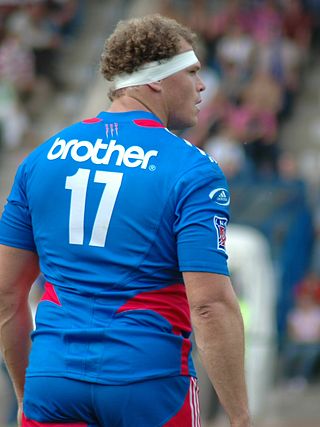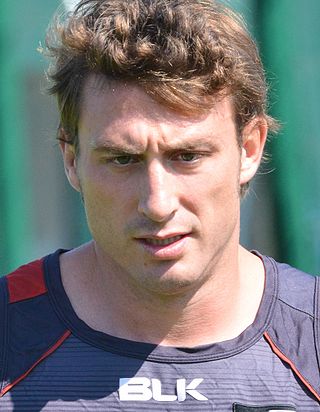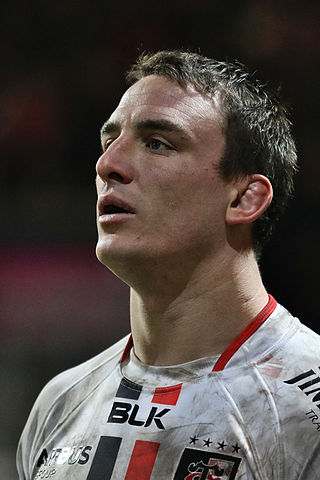
Stade Toulousain, also referred to as Toulouse, is a professional rugby union club based in Toulouse, France. They compete in the Top 14, France's top division of rugby, and the European Rugby Champions Cup.

The Top 14 is a professional rugby union club competition that is played in France. Created in 1892, the Top 14 is at the top of the national league system operated by the France National Rugby League, also known by its French initialism of LNR. There is promotion and relegation between the Top 14 and the next level down, the Pro D2. The fourteen best rugby teams in France participate in the competition, hence the name Top 14. The competition was previously known as the Top 16.

Dimitri Yachvili Markarian is a French former rugby union footballer who played as a scrum-half for Biarritz and France. He played for France from 2002 to 2012, earning 61 caps and scoring 373 points. With them he played in the final of the 2011 World Cup losing to New Zealand and won two Grand Slams in 2004 and 2010. In club rugby, he won a European Cup in 2012 and played in two European Cup finals in 2006 and 2010 with Biarritz. With this club, he also won two French championship titles in 2005 and 2006. With his previous club, Gloucester, he was champion of England in 2002. After the end of his playing career, he became a rugby consultant, a career he began while still a player.

Frédéric Michalak is a former French rugby union footballer. His early career was spent playing for his hometown team, Toulouse, in the Top 14 and in the Heineken Cup. He moved to South Africa to play for the Sharks in the Super 14 after the 2007 Rugby World Cup, but after just one year with the Sharks he moved back to Toulouse. He has also played over 70 tests for France to date, and is the country's leading Test point scorer, achieving that milestone in 2015. Michalak originally played scrum-half but has played mainly at fly-half. He has appeared in advertisements for companies such as Nike and Levi's.

Yannick Nyanga is a former professional rugby union player who played as a flanker for Racing 92 and France, and is also known for his long tenure at Toulouse. He was a part of the victorious French team of the 2006 Six Nations Championship.

Fabien Galthié is a French rugby union coach and former player, currently the head coach of the France national team.

Jean-Baptiste Élissalde is a former French rugby union player, playing either as a scrum-half or as a fly-half, and most recently defense coach for Montpellier in the Top 14.

Pieter Joshua de Villiers is a South African-born French rugby union player and coach. As a player he represented France at international level and played in two Rugby World Cups, and ended his club career with Stade Français in the Top 14 competition in France. A prop, he was renowned for his scrummaging ability.

David Skrela is a former French rugby union player. He most notably played for Stade Français and Toulouse in the Top 14 as well as the French national side as a fly-half or centre. He was renowned for his tackles and his kicking skills.

Lionel Beauxis, born on October 24, 1985, in Tarbes (Hautes-Pyrénées), is a French rugby union player who primarily played as a fly-half.

Émile "Milou" Ntamack is a French former rugby union footballer. He played professionally for Stade Toulousain and France, winning 46 caps. Ntamack made his French debut against Wales during the 1994 Five Nations Championship. Ntamack was part of the Grand Slam winning sides in 1997. He was in the 1995 and 1999 World Cup squads. He initially announced his retirement in 2003 due to a facial injury, however he then stayed on for another year before retiring in 2004. His younger brother, Francis Ntamack was also capped by France. Ntamack coached the Espoirs team of the Stade Toulousain and the French U21 team which was the first Northern Hemisphere side to win the World Championships in this age category, held in the Auvergne in 2006.

Maxime Médard is a former French rugby union player who plays his club rugby for French club Stade Toulousain in Top 14 and France internationally. He can play as both a full-back and on the wing and is described by assistant national team coach Émile Ntamack as an "incredible talent" that, during the 2010–11 season, was finally "realizing his potential". Medard is a two-time winner of the Heineken Cup and, in 2008, won the Top 14 for the first time. Also referred to as 'The French Wolverine.'

Louis Picamoles is a former French professional rugby union player who most recently played for Bordeaux Bègles in the Top 14. Picamoles's usual position was at number eight.

Pierre Guillemin was a French rugby union player, who represented France, Paris and Racing Club de France (RCF).

Jean-Marc Doussain is a French rugby union fly half. He plays club rugby for Lyon OU and has appeared for the French national U20 side. He made his debut for France with 5 minutes left of the 2011 Rugby World Cup final, becoming the first player ever to make his Test debut in a Rugby World Cup final. Doussain wasn't initially named in the squad and was only called up as an injury replacement for David Skrela.

Blair Simon Kinghorn is a Scottish professional rugby union player who plays as a fullback for Top 14 club Toulouse and the Scotland national team.

Antoine Dupont is a French professional rugby union player who plays as a scrum-half for Top 14 club Toulouse and captains the France national team.

Romain Ntamack is a French professional rugby union player who plays as a fly-half for Top 14 club Toulouse and the France national team.

Ange Capuozzo is a professional rugby union player who plays as a full-back or a wing for French Top 14 club Toulouse and the Italian national team.

Emmanuel Latu-Meafou is a professional rugby union player who plays as a lock for Top 14 club Toulouse and the France national team. Born in New Zealand to parents from Samoa, before moving to Australia where he was raised, he later obtained French nationality in 2023 and made his debut for his adoptive country in 2024.





















